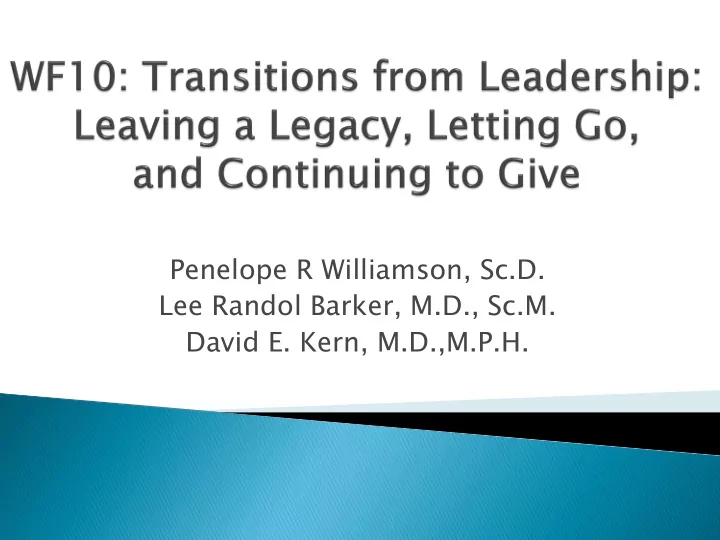

Penelope R Williamson, Sc.D. Lee Randol Barker, M.D., Sc.M. David E. Kern, M.D.,M.P.H.
Think of one or two moments in your career 1. as a leader that makes you most proud. What am I looking forward to and what am I 2. fearful of in my transition from leadership? How can I transition in such a way that the 3. group is healthy, wealthy, and wise?
Can you plan all transitions / any transition? Is being abrupt sometimes good? If you stay, will you inhibit independence and growth by successors? Canasta, too many cards for child, asks for help; planning vs sharing issues and challenges with others; is it better if the group navigates? Sense of being helpful to other people an enduring theme; this can help prepare future leaders. Your perception of your identity after transitions, and others’ perception of your identity.
Distinguishing what you are / have been in your role vs. what title means. Protecting and preparing the group so the group is ready for the transition. “Information interviews”: interviewing others about how they have transitioned, about opportunities. Discover that life after leadership can be enriching and have great returns. Preparing for transitions in mentor / mentee relationship. Reflection on past transitions. Reflection on loss of previous identity. Is role part of who you are?
Leaving a comfort zone. Loss vs uncertain gain. Backdrop for those older, faculties may decline. Story of “companions” to tribal leader, with leader throughout leadership, leader determines time of own death. New personal growth for leader from transition. There is a pastoral literature on the succession of pastors; the previous pastor, who has personal relations with so many of the congregation, tends to leave the area.
Transition from Leadership
Gains: increased control over activities, relaxed schedule, increased balance, new activities, personal growth Losses: power, identity, purpose, structure, interactions with colleagues and learners How organizations can help: retirement planning, part-time options, encouragement of ongoing engagement What you can do: financial planning, health care planning, clarify goals, plan for meaningful activities and use of your abilities, plan opportunities for interactions with others, decide regarding part-time work
Develop a plan , permit sufficient time Conduct a needs assessment : leader’s position and competencies, faculty and staff needs, knowledge transfer Identify potential candidates Communicate , solicit input, make an open process Successor preparation and training , setting up process for transition . Devote sufficient resources Results in better transitions and outcomes, in general Exceptions: sick organization, needs new blood from outside.
Factual Cultural Organizational Social / Relational within and beyond organization Plan for how to transfer all types of knowledge.
Benefits Retention of talent Increased faculty satisfaction More time for transition planning Ideally Cost-neutral or beneficial to organization Coordinated with benefit structure Encourages rather than discourages part-time work Downside Less turnover and opportunity for new talent
An idea or action that I will pursue when I go home .
Recommend
More recommend